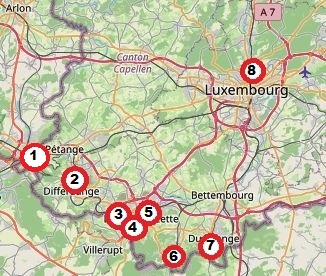 |  |
The iron industries in Luxemburg were very important for the railways in the country. Since many years iron ore was found in the south of the country of Luxemburg. But industries to process the ore could not be of a large scale. Iron was melted and would be changed to pig iron by low temperature furnaces and hand work.
Only when the high temperature blast furnace was invented, processing on a larger scale could take place. To feed the blast furnace there is a need for large amounts of iron ore (no problem in Luxemburg) and coal. The coal had to be imported. For this railways were built. By this, coal could be imported from several areas in Germany. And the readymade iron, steel and iron products could be exported by rail.
Between 1860 and 1900 on several locations iron industries were founded. Below I will describe several industrial locations where a blast furnace and/or a steel factory was situated. In the beginning the factories were of different owners. From 1911 three of them merged into the Arbed (Aciéries Réunies de Burgbach-Eich-Dudelange). Later others came to it, so that around the Second World War the Arbed was the only steel processing industry in Luxemburg. Later Arbed has been merged with others so that today Arcelor-Mittal is the largest steel processing firm of the world.
ARBEDARBED (Aciéries Réunies de Burbach-Eich-Dudelange) was created in 1911 as an amalgamation of three industries:
In the first year 1911 of the combinated firm there were 21 blast furnaces, 3 electric ovens, 2 steel factories and several rolling mills. The total production in that year was already 824.000 tons of iron. After the First World War several companies in Belgium and Germany were included into the firm. In 1937 Arbed and s.m.des Terres Rouges formed went together. After the Second World War a large expansion took place. In 1974 the production of Arbed was 6,45 million tons. In railway terms, that is an average of almost 300 goods wagons of 60 ton capacity every day. The firm contributed to 30% of the income of the country of Luxemburg. In 1973 the oil crisis came. Worldwide there was an overproduction of steel. So production was reduced; in 1983 there was only a production of 3,2 million ton. In 1983 the state of Luxemburg took 42,9% of the shares of Arbed. Later on the firm expanded worldwide with acquisition of several steel factories. In Luxemburg the processing of iron ore stopped, in 1997 the last blast furnace was stopped. In 2002 Arbed (Lux), Aceralia (Spanish) and Usinor (French) merged into Arcelor with headquarters in Luxemburg. In 2006 the firm was taken over by Mittal Steel (a large Indian steel processing firm) and the name became Arcelor Mittal. This firm, with headquarters in Luxemburg, is today the largest steel processing firm. |
Below you find a description of several locations where iron industries were established. Click on one of the linkd to read more.

1. Rodange
2. Differdange
3. Esch Belval
4. Esch Rothe Erde
5. Schifflange
6. Rumelange
7. Dudelange
8. Dommeldange